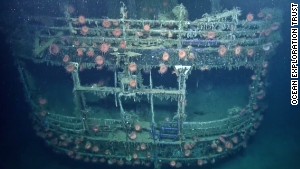A U-boat and its American prey haunt Gulf of Mexico
updated 8:30 PM EDT, Wed July 16, 2014
Source: HLN
Now, the future has come to take a closer look.
From July 6 to 14, the
211-foot research ship Exploration Vessel Nautilus conducted dives to
the final resting places of the American steamer SS Robert E. Lee and
the German U-boat U-166, about 45 miles south of the Mississippi River
delta.
The Robert E. Lee was
torpedoed by the U-166 while ferrying victims of other U-boat attacks
from Trinidad to New Orleans. The sub succumbed to depth charges fired
from an escort ship. These doomed ships are now separated by only two miles of seabed.
The Nautilus is operated
by the Ocean Exploration Trust, a research group founded in 2008 for the
purpose of carrying out "pure ocean exploration," according to the group's website.
The ship carries 17 permanent crew members and a rotating, 31-member
Corps of Exploration composed of scientists, engineers and other special
personnel. It also holds two remotely operated vehicles, Hercules and
Argus, which collect data and samples from deep beneath the ocean's
surface.
 |
| Anemones cling to the side of the SS Robert E. Lee. |
The purpose of the
Nautilus' mission to the twin shipwrecks was to perform forensic
archeological documentation to more clearly understand their demises,
said Ocean Exploration Trust spokeswoman Susan Poulton. By the time the
team was finished, it had conducted high-resolution mapping of the area
and created 3-D images of the wrecks.
Assisted by the recent
findings, archeologists have been able to supplement what they already
knew about the attack, Poulton added.
"On July 30th, 1942 at
10:30 p.m., a torpedo from U-166 hit the [Robert E. Lee], which took
about 15 minutes to sink. One officer, nine crewmen, and 15 passengers
died as the vessel went down," according to an article on the Nautilus Live website.
"Once the torpedo was sighted, the passenger ship's armed escort vessel, PC-566,
dropped several depth charges. ... those depth charges sank the U-boat
with all hands." Fifty-two crew members went down with the U-boat,
according to an article on the U.S. Coast Guard's website.
This sort of Nazi incursion into American waters was perhaps more ubiquitous than modern Americans believe.
"Historians say U-boats
sank at least 50 American ships in the Gulf, one in the very mouth of
the Mississippi River. Americans managed to sink only one U-boat in the
Gulf of Mexico," said Poulton.
The nature of these
wrecks as war graves is not taken lightly by the researchers on the
Nautilus, according to Poulton, who quoted the founder of the Ocean
Exploration Trust, Robert Ballard, as saying, "Many souls were lost on
these wrecks and others, but now they are teeming with corals and
undersea creatures. It's the amazing tapestry of life."
The Nautilus will
continue its expedition in the Gulf by examining the effects of the
Deepwater Horizon oil spill and is expected to complete its cruise in
early October. The mission's progress can be tracked live at the Nautilus Live website.

No comments:
Post a Comment